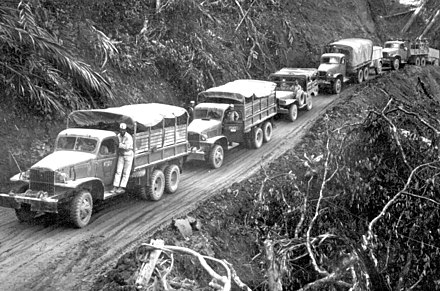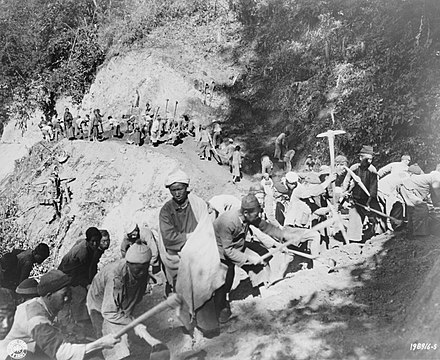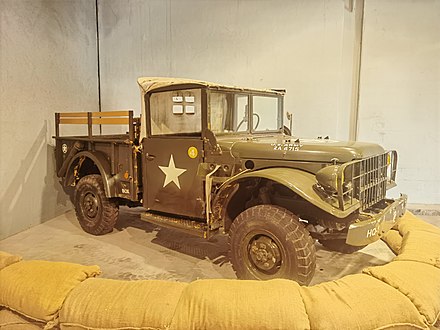Burma Road
Burma Road
The Burma Road runs from Yunnan into Burma; it was built during World War II (see Pacific War for background) to bring supplies to beleaguered China, to help them resist the Japanese invasion. Not much of the original road survives today, but parts of the route can still be travelled.
Understand
The campaign in China, and therefore the Burma Road, was an important part of the war effort, probably more than most Westerners appreciate. From the viewpoint of Japanese expansionists, taking Korea in 1910 and Manchuria in 1931 were very successful moves. However, the Japanese invasion of the Chinese heartland in 1937 turned into a major disaster for both sides. See World War II in China for details.
 The road was initially built by the Chinese and the supplies on it came via British-controlled Burma. Later, the Americans were heavily involved. The US Army Engineers upgraded the road, most of the trucks were American, and most of the drivers were black American soldiers; at the time the US Army did not allow them in combat roles.
The road was initially built by the Chinese and the supplies on it came via British-controlled Burma. Later, the Americans were heavily involved. The US Army Engineers upgraded the road, most of the trucks were American, and most of the drivers were black American soldiers; at the time the US Army did not allow them in combat roles.
There was a good deal of fighting in Burma with the Allies battling Japanese forces that held much of Burma and at one point even threatened India. That was a much more international affair: Allied forces included British, Indian, other Commonwealth, American and Chinese troops. Keeping the road open was an important Allied objective. Chittagong in what is now Bangladesh was one of the most important Allied bases, since it had a good harbour and could be reached by rail without leaving British-controlled territory.
The alternative to the road was "flying the hump", which was taking supply planes from air bases in Assam to ones in and around Kunming over a number of mountain ranges east and south of the main Himalaya chain. This was done by American pilots at great risk. Another Allied objective in Burma was to knock out bases used by Japanese fighters harassing the hump flyers. Today "The Hump" is a popular tourist bar in Kunming and there are commercial flights from Kolkata to Kunming.
There is a Burma Road History Museum in Kunming.
The Burma Road proper

The Burma Road was largely built by the Chinese in 1937 and 1938 — about 200,000 workers with no heavy equipment hacking a road through Western Yunnan and Eastern Burma, from the regional centre Kunming on the Chinese side to the railhead Lashio in Burma (now called Myanmar). The road is about 1150 km (over 700 miles) long and the area is extremely mountainous and heavily forested, so this was an amazing accomplishment.
The Burmese part of the Burma Road is short, from the border town Ruili to Lashio, and can be traversed today only one way (Ruili to Lashio) and only under escort.
Travellers on today's Yunnan tourist trail cover some of this route, albeit on far newer and better roads. Traces of the old road, including some milestones, are still visible.
The Ledo Road
Another road was partly built by the British and Indians, starting in the 1920s, from the railhead Ledo in Assam (Eastern India) over the mountains into Burma. This Ledo Road was upgraded and extended by US Army Engineers during the war, and is also called the Stilwell Road after American General "Vinegar Joe" Stilwell. The total distance on this route from Ledo to Kunming was just over 1,700 km (almost 1,100 miles).
Travelling this road today is nearly impossible. On the Burmese side, the 400 km (250 miles) between the border with India (near Pangsau Pass) and Myitkyina is off-limits to foreigners. The road had mostly returned to the jungle but has been rebuilt, allegedly with forced Naga and Kachin labour. The Myanmar junta is converting this section into an all-weather section for trade with India.
The Indian section of the road, from Ledo to Nampong, is also a restricted area.
Prepare
For holders of most passports heading to this area, a visa will be required for each country you plan to visit — for this route, China, Myanmar (Burma) and perhaps India; see the country articles for details. Visas can be obtained in your home country before you depart or, in most cases, in regional centers near the destinations such as Singapore or Bangkok.
Parts of this route — Assam near the border and Northern Myanmar — are in areas where travel is restricted. You will need permits to visit these; see the linked articles for details. There may be additional complications such as dealing with the rebels who control the area around Laiza as well as with the official government. For most travellers, visiting these areas may be too complicated and risky to consider.
Get in
One end of the road at Kunming is readily accessible, with some international flights plus air, road or rail connections from anywhere in China. See the Kunming article and Hong Kong to Kunming overland. The border town Ruili, on the old Burma Road, is southwest of Kunming and accessible by road or air from there. From Kunming you could also travel northwest, partly on routes close to the old road; see Yunnan tourist trail.
Lashio at the Burmese end of the Burma Road proper and Ledo at the Indian end of the Stilwell Road are harder to reach and there are restrictions on travel beyond them.
Go
If sections of the road open up to travellers, the following are some of the highlights along the Ledo Road and the Burma Road.
Burma and India
- Nampong is a border town in the Indian state of Assam.
- Pangsau Pass, just inside the Indo-Burma border, 1,125 m elevation.
- Pangsau is the first town on the Burmese side.
- Lake of No Return (Nawng Yang).
- Myitkyina, in Kachin State, is open to travellers and is connected by road, rail, air, and ferry from Mandalay.
- Bhamo, also in the Kachin State, is open to travellers.
- Namkham, a village in the Northern Shan State in Burma. Travel to Namkham is restricted and a permit (almost impossible to get) is required from Yangon.
China
- Ruili, a Chinese town at the border with a large bazaar mainly selling Burmese goods. It is reasonably easily reached and quite popular with Chinese travellers, especially for buying jade.
- Mangshi, the capital of Yunnan's Dehong Prefecture. You will need to come here if you decide to travel to Ruili by air.
- Longling, a county in Western Yunnan, site of the Battle of Mount Song, a decisive battle fought in 1944, which finally enabled the Chinese military and the Allied Forces to retake control of the Burma Road from the Japanese. The well-preserved battlefield is now Longling's top tourist attraction. You can also visit the Huitong Bridge, one of the very few surviving bridges on the Burma Road.
- Tengchong, a city in Western Yunnan. Though bypassed by the Burma Road proper, Tengchong was later linked to it via the Stilwell Road. The city played an important role in the Battle of Northern Burma and Western Yunnan. There is a major war cemetery in Tengchong, and the museum near the cemetery has an exhibition on the Burma Road.
- Baoshan, a city in Western Yunnan. The Baoshan Museum has a small exhibition on the Burma Road.
- Yunnanyi, a small town in Xiangyun County, Dali Prefecture. Best accessed via the county seat of Xiangyun County, which has a high-speed train station.
- Chuxiong, an important city in Central Yunnan. Accessible by high-speed train from Dali and Kunming.
- Kunming, provincial capital of Yunnan Province and major tourist centre on the Chinese side.
Museums
- Burma Road History Museum (滇缅公路历史博物馆), 25.028073°, 102.630314°. A museum about the Burma Road. The museum was founded by Chen Daya, the author of a book about the Overseas Chinese drivers and mechanics who came to China to work on the Burma Road. The museum does not have a lot of artefacts, but has many photographs, illustrations and models. The most valuable and authentic item on display is an old case used for carrying items along the Burma Road. If you understand Mandarin, a friendly guide dressed in period costume can give you a free tour of the museum. A signed copy of Chen's book (published in Chinese only) can be purchased from the museum gift shop. 2021-07-24

- Stilwell Road Museum (史迪威公路博物馆), 24.98548849893955°, 98.51803504979561°. A privately-run museum about the Stilwell Road. The museum maintains a very impressive collection of World War II-era military vehicles, including dozens of jeeps and trucks. 2022-08-25
- Western Yunnan Memorial to War of Resistance Against Japan (滇西抗战纪念馆), 25.028958°, 98.481651°. Large museum dedicated to the Western Yunnan campaign of World War II. It features exhibitions on both the Burma Road and the Stilwell Road, and unlike the two museums mentioned above, it has a lot of information in English, though captions for individual items tend to be in Chinese only. 2019-01-27
- Memorial Park for Overseas Chinese Drivers and Mechanics from Southeast Asia in Chinese People's War of Resistance against Japanese Aggression (南侨机工回国抗日纪念公园), 24.085733°, 98.073813°. Dedicated to the more 3000 Overseas Chinese drivers and mechanics who chose to leave their homes in Southeast Asia in order to work on the Burma Road. There is a museum in the middle of the park. 2022-09-13
Stay safe
As anywhere in Asia, routine precautions against pickpockets and tourist scams are advisable, though the risks here are likely lower than in more heavily-touristed areas. Altitude sickness may also be a hazard on parts of the route.
Much of this area is relatively isolated mountain country that sees very few tourists; be sure your health, skills and equipment are adequate before setting out. Consider hiring a guide who speaks the local language.